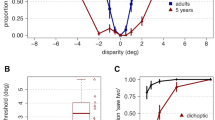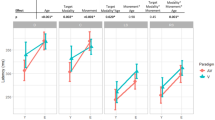Abstract
Natural aging entails progressive deterioration in a variety of biological systems. This study focuses on visual and vestibular influences on human eye movements as a function of aging. Eye movements were recorded (search-coil technique) during visual, vestibular, and combined stimuli in subjects across a broad range of ages (18–89 years). Two types of visual following were assessed: smooth pursuit (SP) of a small discrete target, and optokinetic (OKR) following of a large-field striped image. The vestibulo-ocular reflex (VOR) was studied during head rotation in darkness. Visualvestibular interactions were recorded during rotation in two ways: when the optokinetic scene was earth-fixed, resulting in visual enhancement of the VOR (VVOR), and when the visual image was head-fixed, allowing visual suppression of the VOR (VSVOR). Stimuli consisted of horizontal sinusoidal oscillations over the frequency range 0.025–4 Hz. Trials were analyzed to yield response gain (peak horizontal eye/stimulus velocities) and phase (asynchrony, in degrees, between eye and stimulus velocity signals). VOR gain in young subjects was greatest (near 0.9) at 2.5–4 Hz but declined steadily with decreasing frequency, while phase hovered near zero until 0.1 Hz and then developed a progressively increasing lead. Effects of advancing age were small, given the modest head velocities presented, and were most noticeable as an increase in phase lead and decline in gain at the lowest frequencies (≤0.1 Hz). The two forms of visual following and all conditions of visual-vestibular interactions displayed more prominent age-dependent changes. OKR and SP response characteristics (0.25–4 Hz) closely resembled each other. Gain was greatest at 0.25 Hz, while phase was near 0°. As frequency increased, gain declined while phase lag rose. However, both gain and phase lag tended to be slightly greater for OKR than for SP responses. Both SP and OKR response properties deteriorated progressively with increasing age, as witnessed by a progressive decline in gain and increase in phase lag, even at modest frequencies (e.g., 0.25–1.0 Hz). VVOR responses were generally closer to the ideal of 1.0 in gain and 0° in phase than either the VOR or visual following alone. A subtle but significant age-dependent decline in VVOR performance occurred at the lowest frequencies. VSVOR response characteristics were close to those of the VOR and VVOR at 4 Hz, where visual influences on eye movements are generally inconsequential. As frequency declined, visual suppression became more robust and gain dropped. The SP stimulus seemed surprisingly more effective than the OK scene in suppressing the VOR, but this effect is predicted by a linear model of visual-vestibular interactions. As age increased, visual influences on the VOR became progressively weaker, in concert with deterioration of visual following. The subjective sensation of circular vection (CV), a psychophysical measure of VVI, was assessed during optokinetic stimulation at 0.025 Hz. Interestingly, the likelihood and intensity of CV increased with aging, suggesting that visual inputs to the perception of self-motion are enhanced in the elderly. This may represent a form of visual compensation for age-dependent loss of vestibular self-rotation cues. In brief, the VOR, visual following, and their interactions display specific changes in response properties as a function of natural aging. The modifications may be interpreted as age-dependent deteriorations in the performance of systems underlying the control of human eye movements.
Similar content being viewed by others
References
Bahill AT, McDonald JD (1983) Smooth pursuit eye movements in response to predictable target motions. Vision Res 23:1573–1583.
Baloh RW, Yee RD, Honrubia V, Jacobson K (1988) A comparison of the dynamics of horizontal and vertical smooth pursuit in normal human subjects. Aviat Space Environ Med 59:121–124.
Barnes GR (1988) Head-eye co-ordination: visual and nonvisual mechanisms of vestibulo-ocular reflex slow-phase modification. Prog Brain Res 76:319–328.
Barr CC, Schultheis LW, Robinson DA (1976) Voluntary, non-visual control of the human vestibulo-ocular reflex. Acta Otolaryngol (Stockh) 81:365–375.
Boyle R, Büttner UW, Markert G (1985) Vestibular nuclei activity and eye movements in the alert monkey during sinusoidal optokinetic stimulation. Exp Brain Res 57:362–369.
Büttner UW, Henn VS (1981) Circularvection: psychophysics and single-unit recordings in the monkey. Ann NY Acad Sci 374:274–283.
Carl JR, Gellman RS (1987) Human smooth pursuit: stimulus-dependent responses. J Neurophysiol 57:1446–1463.
Cheung BSK, Howard IP, Nedzelski JM, Landolt JP (1989) Circularvection about earth-horizontal axes in bilateral labyrinthine-defective subjects. Acta Otolaryngol [Suppl 108]:336–344.
Cohen B, Matsuo V, Raphan T (1977) Quantitative analysis of the velocity characteristics of optokinetic nystagmus and optokinetic after-nystagmus. J Physiol (Lond) 270:321–344.
Collewijn H, Van der Mark F, Jansen TC (1975) Precise recording of human eye movement. Vision Res 15:447–450.
Collewijn H, Tamminga EP (1984) Human smooth and saccadic eye movements during voluntary pursuit of different target motions on different backgrounds. J Physiol (Lond) 351:217–250.
Cullen KE, Belton T, McCrea RA (1991) A non-visual mechanism for voluntary cancellation of the vestibulo-ocular reflex. Exp Brain Res 83:237–252.
Dichgans JM, Brandt T (1978) Visual-vestibular interaction: Effects on self-motion perception and postural control. In: Held R, Leibowitz HW, Teuber H-L (eds) Handbook of sensory physiology, vol 8, perception. Springer, Berlin Heidelberg New York, pp 756–804.
DiZio P, Lackner JR (1990) Age differences in oculomotor responses to step changes in body velocity and visual surround velocity. J Gerontol 45:89–95.
Fetter M, Zee DS (1988) Recovery from unilateral labyrinthectomy in rhesus monkey. J Neurophysiol 59:370–393.
Furst EJ, Goldberg JM, Jenkins HA (1987) Voluntary modification of the rotatory induced vestibuloocular reflex by fixating imaginary targets. Acta Otolaryngol (Stockh) 103:232–240.
Heide W, Koenig E, Dichgans J (1990) Optokinetic nystagmus, self-motion sensation and their aftereffects in patients with occipito-parietal lesions. Clin Vision Sci 5:145–156.
Ireland DJ, Jell RM (1982) Optokinetic after-nystagmus in man after loss or reduction of labyrinthine function -a preliminary report. J Otolaryngol 11:86–90.
Jell RM, Stockwell CW, Turnipseed GT, Guedry FE (1988) The influence of active versus passive head oscillation, and mental set on the human vestibulo-ocular reflex. Aviat Space Environ Med 59:1061–1065.
Kasteel-van Linge A, Maas AJJ (1990) Quantification of visuo-vestibular interaction up to 5.0 Hz in normal subjects. Acta Otolaryngol (Stockh) 110:18–24.
Lafortune S, Ireland DJ, Jell RM, DuVal L (1986) Human optokinetic afternystagmus: stimulus velocity dependence of the two component decay model and involvement of pursuit. Acta Otolaryngol (Stockh) 101:183–192.
Larsby B, Thell J, Möller CG, Ödkvist LM (1988) The effect of stimulus predictability and age on human tracking eye movements. Acta Otolaryngol (Stockh) 105:21–30.
Lisberger SG, Evinger C, Johanson GW, Fuchs AF (1981a) Relationship between eye acceleration and retinal image velocity during foveal smooth pursuit in man and monkey. J Neurophysiol 46:229–249.
Lisberger SG, Miles FA, Optican LM, Eighmy BB (1981b) Optokinetic response in monkey: underlying mechanisms and their sensitivity to long-term adaptive changes in vestibuloocular reflex. J Neurophysiol 45:869–890.
Lisberger SG (1990) Visual tracking in monkeys: evidence for short-latency suppression of the vestibuloocular reflex. J Neurophysiol 63:676–688.
McKinley PA, Peterson BW (1985) Voluntary modulation of the vestibuloocular reflex in humans and its relation to smooth pursuit. Exp Brain Res 60:454–464.
Melvill Jones G, Berthoz A, Segal B (1984) Adaptive modification of the vestibulo-ocular reflex by mental effort in darkness. Exp Brain Res 56:149–153.
Paige GD (1983a) Vestibuloocular reflex and its interactions with visual following mechanisms in the squirrel monkey. I. Response characteristics in normal animals. J Neurophysiol 49:134–151.
Paige GD (1983b) Vestibuloocular reflex and its interactions with visual following mechanisms in the squirrel monkey. II. Response characteristics and plasticity following unilateral inactivation of horizontal canal. J Neurophysiol 49:152–168.
Paige GD (1989) Nonlinearity and asymmetry in the human vestibulo-ocular reflex. Acta Otolaryngol (Stockh) 108:1–8.
Paige GD (1992) Senescence of human visual-vestibular interactions: I. Vestibulo-ocular reflex and adaptive plasticity with aging. J Vest Res 2:133–151.
Paige GD, Sargent EW (1991) Visually-induced adaptive plasticity in the human vestibulo-ocular reflex. Exp Brain Res 84:25–34.
Peterka RJ, Black FO, Schoenhoff MB (1990a) Age-related changes in human vestibulo-ocular reflexes: sinusoidal rotation and caloric tests. J Vest Res 1:49–59.
Peterka RJ, Black FO, Schoenhoff MB (1990b) Age-related changes in human vestibulo-ocular and optokinetic reflexes: pseudorandom rotation tests. J Vest Res 1:61–71.
Radebaugh TS, Hadley E, Suzman R (1985) Falls in the elderly: biologic and behavioral aspects. (Clinics in geriatric medicine) Saunders, Philadelphia.
Raphan T, Matsuo V, Cohen B (1979) Velocity storage in the vestibulo-ocular reflex arc (VOR). Exp Brain Res 35:229–248.
Raphan T, Cohen B (1985) Velocity storage and the ocular response to multidimensional vestibular stimuli. In: Berthoz A, Melvill Jones G (eds) Adaptive mechanisms in gaze control. (Reviews of oculomotor research, vol I) Elsevier, Amsterdam, pp 123–143.
Robinson DA (1963) A method of measuring eye movement using a scierai search coil in a magnetic field. IEEE Trans Biomed Eng 10:137–145.
Robinson DA (1981) Control of eye movements. In: Brooks VB (ed) Handbook of physiology, sect 1, The nervous system, vol II (2) Williams & Wilkins, Baltimore, pp 1275–1320.
Segal BN, Liben S (1985) Modulation of human velocity storage sampled during intermittently-illuminated optokinetic stimulation. Exp Brain Res 59:515–523.
Sharpe JA, Sylvester TO (1978) Effect of aging on horizontal smooth pursuit. Invest Ophthalmol Vis Sci 17:465–468.
Simons B, Büttner U (1985) The influence of age on optokinetic nystagmus. Eur Arch Psychiatry Neurol Sci 234:369–373.
Spooner JW, Sakala SM, Baloh RW (1980) Effect of aging on eye tracking. Arch Neurol 37:575–576.
Straube A, Brandt T (1987) Importance of the visual and vestibular cortex for self-motion perception in man (circularvection). Human Neurobiol 6:211–218.
Tijssen MA, Straathof CS, Hain TC, Zee DS (1989) Optokinetic afternystagmus in humans: normal values of amplitude, time constant, and asymmetry. Ann Otol Rhinol Laryngol 98:741–746.
Tychsen L, Lisberger SG (1986) Visual motion processing for the initiation of smooth-pursuit eye movements in humans. J Neurophysiol 56:953–968.
Van den Berg AV, Collewijn H (1986) Human smooth pursuit: effects of stimulus extent and of spatial and temporal constraints of the pursuit trajectory. Vision Res 26:1209–1222.
Vercher J-L, Gauthier GM (1991) Eye-head movement coordination: vestibulo-ocular reflex suppression with head-fixed target fixation. J Vest Res 1:161–170.
Waespe W, Henn VS (1985) Cooperative functions of the vestibular nuclei neurons and floccular Purkinje cells in the control of nystagmus slow phase velocity: single cell recordings and lesion studies in the monkey. In: Berthoz A, Melvill Jones G (eds) Adaptive mechanisms in gaze control. (Reviews of oculomotor research, vol 1) Elsevier, Amsterdam, pp 233–250.
Waespe W, Wolfensberger M (1985) Optokinetic nystagmus (OKN) and optokinetic after-responses after bilateral vestibular neurectomy in the monkey. Exp Brain Res 60:263–269.
Wall C III, Black FO, Hunt AE (1984) Effects of age, sex and stimulus parameters upon vestibulo-ocular responses to sinusoidal rotation. Acta Otolaryngol (Stockh) 98:270–278.
Waterston JA, Barnes GR (1992) Visual-vestibular interaction during head-free pursuit of pseudorandom target motion in man. J Vest Res 2:71–88.
Wyatt HJ, Pola J (1988) Predictive behavior of optokinetic eye movements. Exp Brain Res 73:615–626.
Yasui S, Young LR (1984) On the predictive control of foveal eye tracking and slow phases of optokinetic and vestibular nystagmus. J Physiol (Lond) 347:17–33.
Yee RD, Daniels SA, Jones OW, Baloh RW, Honrubia V (1983) Effects of an optokinetic background on pursuit eye movements. Invest Ophthalmol Vis Sci 24:1115–1122.
Zackon DH, Sharpe JA (1987) Smooth pursuit in senescence. Acta Otolaryngol (Stockh) 104:290–297.
Zee DS, Yee RD, Robinson DA (1976) Optokinetic responses in labyrinthine-defective human beings. Brain Res 113:423–428.
Author information
Authors and Affiliations
Rights and permissions
About this article
Cite this article
Paige, G.D. Senescence of human visual-vestibular interactions: smooth pursuit, optokinetic, and vestibular control of eye movements with aging. Exp Brain Res 98, 355–372 (1994). https://doi.org/10.1007/BF00228423
Received:
Accepted:
Issue Date:
DOI: https://doi.org/10.1007/BF00228423




